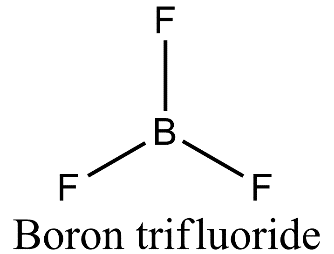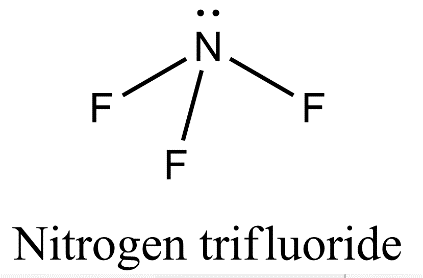
$B{{F}_{3}}$ is a planar molecule whereas $N{{F}_{3}}$ is pyramidal because:
(A) B - F bond is more polar than N - F bond
(B) Boron atom is bigger than nitrogen atom
(C) Nitrogen is more electronegative than boron
(D) $B{{F}_{3}}$ has no lone pair but $N{{F}_{3}}$ has a lone pair of electrons.
Answer
572.4k+ views
Hint: Write the electronic configuration of boron and nitrogen atoms. Draw the structure of boron fluoride and nitrogen trifluoride. Take a look at the types of electron-pairs present in the molecule and then determine the correct reason.
Complete step by step solution:
- Boron has atomic number 5 and nitrogen has atomic number 7. Their electronic configuration is given as follows,
\[{}^{5}B=1{{s}^{2}}2{{s}^{2}}2{{p}^{1}}\]
\[{}^{7}N=1{{s}^{2}}2{{s}^{2}}2{{p}^{3}}\]
- Boron is forming three covalent bonds with fluorine so it is $s{{p}^{2}}$ hybridized due to the presence of three electrons present in the outermost shell. On excitation of boron atom, the electronic configuration will be ${}^{5}B=1{{s}^{2}}2{{s}^{1}}2{{p}^{2}}$ and so, three orbitals of three fluorine atoms will axially overlap with three $s{{p}^{2}}$ hybridized orbitals of boron to form boron trifluoride.

- Nitrogen is also forming three covalent bonds with fluorine but when nitrogen atom is excited, the electronic configuration is ${}^{7}N=1{{s}^{2}}2{{s}^{1}}2{{p}^{4}}$ and so, nitrogen undergoes $s{{p}^{3}}$ hybridization in which one of the $s{{p}^{3}}$ hybrid orbital will have a pair of electrons and three other orbitals will have one electron each. These three orbitals having a single electron will axially overlap with three orbitals of three fluorine atoms to form nitrogen trifluoride.

- Now, since nitrogen contains one lone pair of electrons there will be lone pair- bond pair repulsion which will lead to distortion of trigonal planar geometry. Therefore, nitrogen trifluoride will have pyramidal geometry.
- In case of boron trifluoride, there is vacant 2p orbital and no lone pair of electrons and so there is only bond pair- bond pair repulsion giving rise to trigonal planar geometry.
- Therefore, $B{{F}_{3}}$ is a planar molecule whereas $N{{F}_{3}}$ is pyramidal because $B{{F}_{3}}$ has no lone pair but $N{{F}_{3}}$ has a lone pair of electrons.
- Hence, option (D) is the correct answer.
Note: Remember lone pair - lone pair repulsion is greater than lone pair- bond pair repulsion which is greater than bond pair- bond pair repulsion. Due to the presence of lone pairs, there is distortion of geometry.
Complete step by step solution:
- Boron has atomic number 5 and nitrogen has atomic number 7. Their electronic configuration is given as follows,
\[{}^{5}B=1{{s}^{2}}2{{s}^{2}}2{{p}^{1}}\]
\[{}^{7}N=1{{s}^{2}}2{{s}^{2}}2{{p}^{3}}\]
- Boron is forming three covalent bonds with fluorine so it is $s{{p}^{2}}$ hybridized due to the presence of three electrons present in the outermost shell. On excitation of boron atom, the electronic configuration will be ${}^{5}B=1{{s}^{2}}2{{s}^{1}}2{{p}^{2}}$ and so, three orbitals of three fluorine atoms will axially overlap with three $s{{p}^{2}}$ hybridized orbitals of boron to form boron trifluoride.

- Nitrogen is also forming three covalent bonds with fluorine but when nitrogen atom is excited, the electronic configuration is ${}^{7}N=1{{s}^{2}}2{{s}^{1}}2{{p}^{4}}$ and so, nitrogen undergoes $s{{p}^{3}}$ hybridization in which one of the $s{{p}^{3}}$ hybrid orbital will have a pair of electrons and three other orbitals will have one electron each. These three orbitals having a single electron will axially overlap with three orbitals of three fluorine atoms to form nitrogen trifluoride.

- Now, since nitrogen contains one lone pair of electrons there will be lone pair- bond pair repulsion which will lead to distortion of trigonal planar geometry. Therefore, nitrogen trifluoride will have pyramidal geometry.
- In case of boron trifluoride, there is vacant 2p orbital and no lone pair of electrons and so there is only bond pair- bond pair repulsion giving rise to trigonal planar geometry.
- Therefore, $B{{F}_{3}}$ is a planar molecule whereas $N{{F}_{3}}$ is pyramidal because $B{{F}_{3}}$ has no lone pair but $N{{F}_{3}}$ has a lone pair of electrons.
- Hence, option (D) is the correct answer.
Note: Remember lone pair - lone pair repulsion is greater than lone pair- bond pair repulsion which is greater than bond pair- bond pair repulsion. Due to the presence of lone pairs, there is distortion of geometry.
Recently Updated Pages
Master Class 12 Business Studies: Engaging Questions & Answers for Success

Master Class 12 Economics: Engaging Questions & Answers for Success

Master Class 12 English: Engaging Questions & Answers for Success

Master Class 12 Maths: Engaging Questions & Answers for Success

Master Class 12 Social Science: Engaging Questions & Answers for Success

Master Class 12 Chemistry: Engaging Questions & Answers for Success

Trending doubts
What is meant by exothermic and endothermic reactions class 11 chemistry CBSE

Which animal has three hearts class 11 biology CBSE

10 examples of friction in our daily life

One Metric ton is equal to kg A 10000 B 1000 C 100 class 11 physics CBSE

1 Quintal is equal to a 110 kg b 10 kg c 100kg d 1000 class 11 physics CBSE

Difference Between Prokaryotic Cells and Eukaryotic Cells




